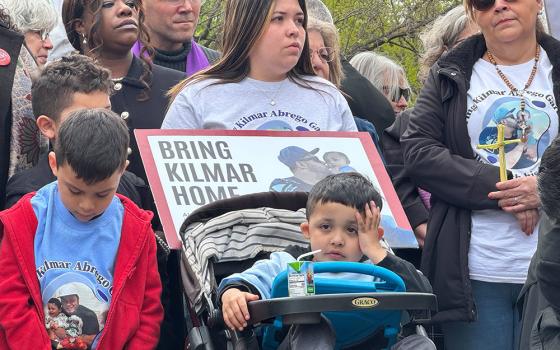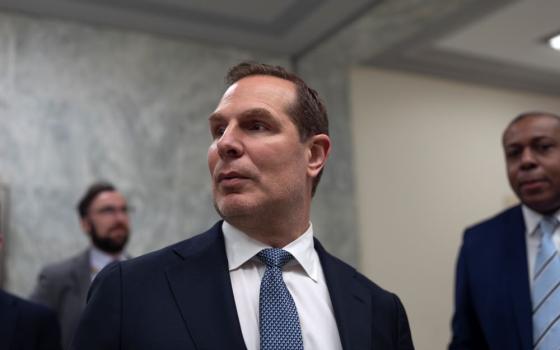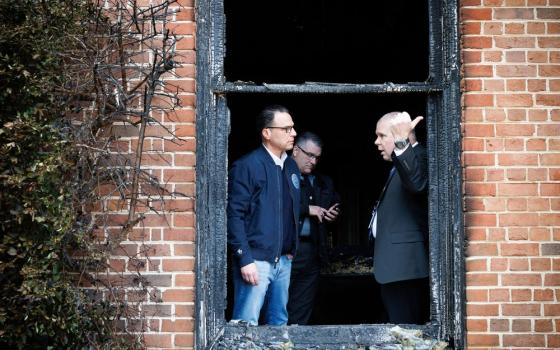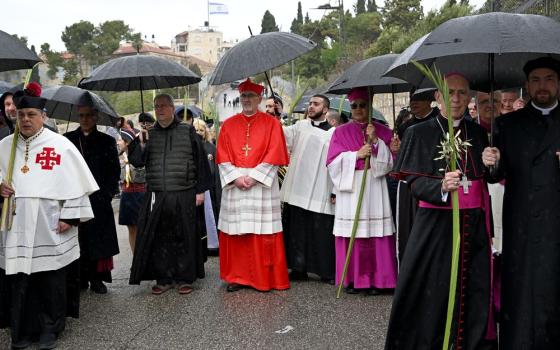
Archbishop John Nienstedt gives a homily at the Basilica of St. Mary Major in Rome in 2012. (CNS/Paul Haring)
An auxiliary bishop in the St. Paul-Minneapolis Archdiocese has said that Archbishop Carlo Maria Viganò told those overseeing the probe into claims of sexual misconduct by Archbishop John Nienstedt to "focus the investigation and complete it, [and] we did so." The statement appears to corroborate reports that the former Vatican ambassador attempted to intervene in the independent inquiry.
The revelation came from Auxiliary Bishop Andrew Cozzens, who in a statement issued late Aug. 31 addressed the Nienstedt investigation in his most extensive public comments on the matter. The more-than-yearlong inquiry — which began in January 2014 at Nienstedt's authorization — resurfaced in recent weeks after Viganò levied charges that high-ranking bishops and Pope Francis covered up abuse allegations regarding ex-Cardinal Theodore McCarrick.
That in turn has renewed questions about Viganò's role in the Nienstedt case, which significantly shifted after an April 2014 meeting between Viganò, who was then nuncio to the U.S., and two auxiliary bishops. What began as a search to determine the truth or falsity of the claims against Nienstedt afterward narrowed to whether the allegations amounted to a "crime or grave delict," with the original investigators eventually replaced.
The allegations, which chancery officials began receiving in fall 2013, claimed that Nienstedt sexually harassed and made sexual advances to adult males; that he had concerning interactions with seminarians, including grooming and reprisals for rejected advances; and that he lived a "promiscuous gay lifestyle" while in Detroit and Rome. There were also concerns about Nienstedt's relationship with former priest Curtis Wehmeyer and an allegation that Nienstedt had had sexual relations with a Swiss Guardsman.
In June 2015, Nienstedt resigned, along with Auxiliary Bishop Lee Piché, 10 days after civil and criminal charges were brought against the archdiocese.
It was the dismissal of criminal charges a year later that revealed, among a trove of documents, details of the investigation into Nienstedt — primarily through a memo dated July 7, 2014. The 11-page memo was authored by Fr. Dan Griffith, who had served as liaison between the archdiocese and Greene Espel, the Minneapolis law firm first hired to conduct the investigation.
Nienstedt, who until mid-August 2018 had been serving as an independent contractor for the Napa Institute, the conservative think tank founded by Timothy Busch, has repeatedly denied all accusations.

Archbishop Carlo Maria Viganò attends a conference on the 1968 encyclical "Humanae Vitae" in Rome Oct. 28, 2017. (CNS/Paul Haring)
Viganò has denied any wrongdoing, saying in a statement dated Aug. 26, "I never told anyone that Greene Espel should stop the inquiry, and I never ordered any document to be destroyed. Any statement to the contrary is false."
In a brief statement, Griffith, a trained civil lawyer and the Wenger Family Faculty Fellow at the University of St. Thomas School of Law in Minneapolis, told NCR, "I stand by my 2014 memo to Bishop Lee Piché. I welcome a thorough accounting of the matter."
'Wrap up the investigation'
Viganò's role centers on an April 12, 2014, meeting at the U.S. nunciature in Washington, D.C., with Viganò, Cozzens and Piché, whom Nienstedt had appointed four months earlier to head the independent investigation.
According to Cozzens, after the archdiocese received nearly a dozen signed affidavits "containing serious allegations of misconduct" against Nienstedt, he and Piché "tried our best to bring them to the attention of people who might have authority to act and guide the investigation." That included Viganò.
"When Bishop Piché and I believed that we were being told by the nuncio to close the investigation, we strenuously objected," Cozzens said in the statement, referring to a letter the auxiliaries wrote to Viganò following their meeting. "When the nuncio clarified that we should focus the investigation and complete it, we did so."

St. Paul-Minneapolis Auxiliary Bishop Andrew Cozzens speaks to participants April 14 during a regional encuentro in Alexandria, Minnesota. (CNS/The Catholic Spirit/Dianne Towalski)
That statement appears to give credence to the account of the D.C. meeting in Griffith's memo, which, reflecting conversations with Piché, stated that Viganò did not view the allegations as serious and "ordered you to have the lawyers quickly interview Archbishop Nienstedt and wrap up the investigation."
"The Nuncio said that the lawyers were not to pursue any further leads," including the allegation with the Swiss Guardsman, wrote Griffith, who at the time was the archdiocesan safe environment delegate.
Viganò in his Aug. 26 statement confirmed he received the bishops' letter the day after the 2014 meeting, describing it as "falsely asserting that I had suggested the investigation be stopped."
At the same time, the former nuncio admitted interjecting himself into the investigation, saying, "I suggested to the bishops ... that they tell the Greene Espel lawyers that it appeared to me appropriate that Archbishop Nienstedt be heard" before their investigation extended to the Swiss Guard.
There was no indication that the Greene Espel attorneys had not intended to interview Nienstedt as part of their investigation.
In his memo, Griffith recounted that Viganò asked Piché to take back their letter and destroy it, a directive the priest called "most distressing" since the destruction of evidence is a crime under federal and state law.
While Viganò denies ordering any document destroyed, he said he instructed Piché "to remove from the computer and the archdiocesan archives the letter falsely asserting that I had suggested the investigation be halted." He said he did so "not only to protect my name, but also that of the Nunciature and the Holy Father who would be unnecessarily harmed by having a false statement used against the Church."
In a separate letter, dated Nov. 20, 2014 — one of several documents produced by Viganò last week to the conservative Catholic website LifeSiteNews in an effort to corroborate his story — Piché noted the nuncio's request for clarification regarding the D.C. meeting: "Archbishop Viganò clarified that he did not at that time absolutely rule out any further investigation, but rather was concerned that we first begin to obtain testimony from Archbishop Nienstedt and additional testimony in his defense before undertaking any new phases of the investigation."
In an Aug. 2, 2016, interview with archdiocesan newspaper The Catholic Spirit, Archbishop Bernard Hebda, Nienstedt's successor in the Twin Cities archdiocese, confirmed Griffith's account that the investigation shifted its focus after the Viganò meeting.

Archbishop Bernard Hebda takes the cathedra, or bishop's chair, during his installation Mass May 13, 2016, at the Cathedral of St. Paul in St. Paul, Minnesota. Escorting the new archbishop of St. Paul-Minneapolis to the cathedra is Archbishop Carlo Maria Viganò, former apostolic nuncio to the United States. (CNS/The Catholic Spirit/Dave Hrbacek)
"On their return, Bishop Piché continued his efforts to complete the investigation. He focused the scope of the inquiry on whether there was credible evidence that Archbishop Nienstedt had committed a 'grave delict or crime,' " Hebda said.
He added, "In early July, after Greene Espel had interviewed Archbishop Nienstedt and others, Bishop Piché directed Greene Espel to conclude its report without conducting additional investigation beyond what it had already done to that point. As is reflected in the memorandum ... this directive was controversial internally and led to a breakdown in the investigation. From what I know, different people had very different, yet strongly held, beliefs on how to proceed."
The archdiocese did not respond to additional questions from NCR, including whether it will publicly release the full reports of investigation into Nienstedt.
Confusion about who was in charge
Two days before the April 2014 Viganò meeting, Greene Espel attorneys Matthew Forsgren and David Wallace-Jackson gave a preliminary briefing to a group of chancery officials: Piché, Cozzens, Griffith, vicar general Fr. Charles Lachowitzer and outside counsel Brian Wenger.
According to Griffith's memo, the officials were unanimous that the evidence to date, 10 signed sworn affidavits (an 11th came afterward), was "compelling" and warranted Nienstedt's resignation. They decided the auxiliary bishops would fly to Washington to meet with the nuncio, with hopes "to reach a pastoral resolution for the good of the Archdiocese."
After the auxiliary bishops met with Viganò, Griffith said Piché called him from the airport, saying he "believed a resolution of the matter was on the horizon."
Rather than a resolution, the investigation took a sharp turn.
Within two months, Greene Espel withdrew from the investigation, despite having at least 24 leads left to pursue. Criminal defense attorney Peter Wold was brought in to complete the work.
"In retrospect, it was doomed to fail," Cozzens said of the investigation in his statement. "We did not have enough objectivity or experience with such investigations. Nor did we have authority to act. Throughout our efforts, we did not know where we could turn for assistance, because there was no meaningful structure to address allegations against bishops."
One confidante the auxiliary bishops turned to was New York Cardinal Timothy Dolan, who according to a report by Crux advised they document their interactions and encouraged them to bring information directly to Viganò. In an email Sept. 5, Joseph Zwilling, director of communications for the New York Archdiocese, declined to make any further statements on the matter and said the archdiocese would not provide any additional details about their conversations.
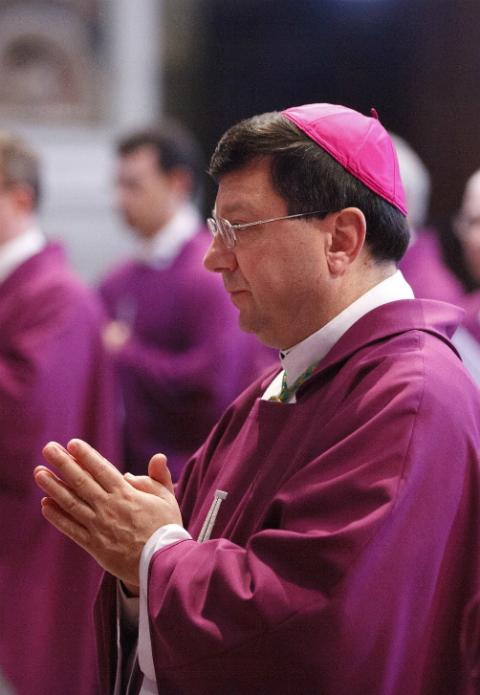
Bishop Lee Piché, then auxiliary of the St. Paul-Minneapolis Archdiocese, at the Vatican in 2012 (CNS/Paul Haring)
Cozzens said, "Throughout this process, there was confusion about who was ultimately in charge and what should be done to ensure a fair outcome." He added that "on more than one occasion" he counseled Nienstedt to resign for the good of the archdiocese.
An unanswered question is why Greene Espel would withdraw from an incomplete investigation if there wasn't a directive to limit and wrap up its work.
While Cozzens said that Piché decided to hire a second firm to complete the review in part because of Nienstedt's contentions that Greene Espel had been unfair to him, Griffith's memo makes it clear that the firm withdrew itself after its work was narrowed and questions arose about the independence of the investigation.
It remains unclear what changed in Piché's thinking that led him from believing that Nienstedt should resign, to deciding to limit the investigation's scope and bring in Wold as the new investigator.
NCR was unable to reach Piché for this story.
After the auxiliary bishops met with Viganò, the nuncio met alone with Nienstedt, who was invited to join the trip. What happened in that meeting is unknown.
Around the time of the Viganò meeting, according to a report from Minnesota Public Radio, Nienstedt and his supporters began privately pushing back against the investigation by accusing the Greene Espel attorneys of bias stemming from their support for same-sex marriage, accusations Viganò would repeat in his Aug. 26 statement.
Griffith in his memo speculated that Nienstedt "may have convinced" Viganò that the allegations were false and part of a conspiracy, a position Nienstedt put forward to media that July after news broke of the investigation. The priest also noted that before the investigation began, Nienstedt's attorney, Jon Hopeman, had contacted him "aggressively" demanding the names of people making allegations and "referred to the matter as a witch-hunt."
In his statement, Viganò alleged Greene Espel "had conducted an inquiry in an unbalanced and prosecutorial style." He also appeared to question the firm's impartiality due to its alleged affiliation with a group called "Lawyers for All Families," which he said opposed Nienstedt during a 2012 Minnesota ballot issue that sought to outlaw same-sex marriage.
Advertisement
The group Viganò appeared to reference is Lawyers United for All Families, an arm of Minnesotans United for All Families, which was the official campaign opposing the amendment. Greene Espel as a firm did not belong to either organization.
Forsgren, in a written statement to MPR News in June 2015, said that he donated $250 to Lawyers United for All Families, and that the contribution was "publicly disclosed on my website biography for years."
As the archdiocese considered Forsgren for the investigation in January 2014, it knew of the donation, Griffith's memo noted, and Wenger, the outside counsel who had worked with Forsgren at another firm, vouched for his ability to lead the inquiry, telling Griffith, "Matt was a person of integrity who would not be biased because of this issue."
Viganò asks for public correction
At the end of his statement, Viganò said that when The New York Times and other outlets reported on Griffith's memo on July 21, 2016, Pope Francis that day asked his secretary of state, Cardinal Pietro Parolin, to call Archbishop Christophe Pierre, Viganò's successor as ambassador, to order an investigation into Viganò's conduct, "so that I could be reported to the tribunal in charge of judging abuse cover-up by bishops."
Viganò said he informed both Jesuit Fr. Federico Lombardi and Greg Burke, the past and current heads of the Vatican press office, of the order. He said that U.S. lawyer Jeffrey Lena — who has defended the Vatican in U.S. courts for two decades — found documents at the Congregation for Bishops "proving that my conduct had been absolutely correct" and gave a written report to the pope exonerating Viganò.
Viganò added the nunciature provided a detailed report to Parolin that reached the same conclusion, and that the reports are located in the secretariat and the U.S. nunciature.
Viganò said he has repeatedly attempted to contact Hebda and Pierre, "asking them to publicly correct the Griffith memorandum," but has not heard back from either, beyond a confirmation from Pierre that he had passed a January 2017 letter on to Hebda.
In the two years since Griffith's memo became public, the St. Paul-Minneapolis Archdiocese has not issued any statement contradicting or discrediting information the priest detailed concerning the Nienstedt investigation.
After a query from NCR Aug. 28, the Vatican press office declined to comment about Viganò's claim that it was informed about such a report. The U.S. apostolic nunciature also declined comment.
The St. Paul-Minneapolis Archdiocese likewise did not respond to questions about any review of the former ambassador's role in the investigation.
Griffith told NCR he was never contacted by anyone regarding any type of investigation into Viganò's conduct.
[Brian Roewe is an NCR staff writer. His email address is broewe@ncronline.org. Follow him on Twitter: @BrianRoewe.]




